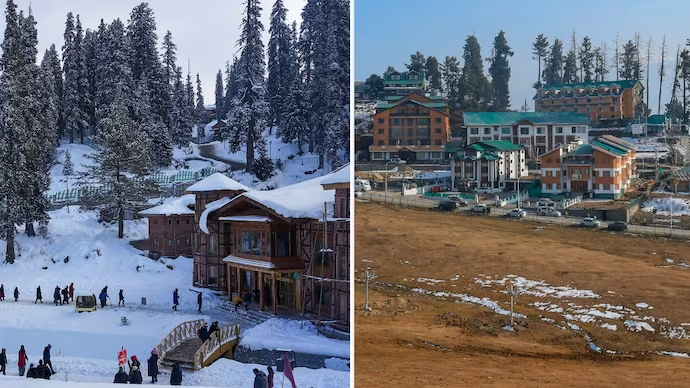This winter, there has been very little to no snowfall in the Kashmir Valley. It has negatively impacted tourism and may force a postponement of the Khelo India Winter Games. However, the absence of snowfall is not the only thing, and it may have more detrimental effects.

There isn’t the customary white cover. And so are the tens of thousands of ecstatic tourists fighting with snowballs. Across the drab, parched terrain where sledges once skimmed down snowy slopes at this time of year, horses can be seen.
Kashmir’s snowless winter has harmed tourism and may necessitate a postponement of the Khelo India Winter Games. But the effects of the absence of snow in the middle and lower Himalayan regions extend beyond travel and recreation.
As the snow replenishes Jhelum, its tributaries, and other wetlands, there may be a water crisis in Jammu and Kashmir this summer.
IndiaToday was informed by Mukhtar Ahmad, the director of the Indian Meteorological Department in Srinagar.According to this, things “could turn dire as there might not be enough water to feed the snow-fed rivers” come summertime.
Then there may be long-range apocalyptic situations.
Vice-president of metrology and climate change at Skymet Mahesh Palawat told IndiaToday that “the glaciers will melt at a faster pace due to less or no snowfall, so the glaciers won’t get recharged.”Within. He warned that if the pattern persisted, snow-fed rivers might eventually dry up.
In Jammu and Kashmir, popular tourist spots like Srinagar, Sonmarg, and Gulmarg have seen little to no snowfall. In Himachal Pradesh, where there hasn’t been any snowfall, the situation is comparable in Shimla and Manali. There hasn’t even been any snowfall in Auli, Uttarakhand.
On Sunday, January 14, the highest temperature in Srinagar, the capital of Jammu and Kashmir, reached a high of 15 degrees Celsius. In contrast, Delhi’s highest recorded temperature was 16 degrees Celsius.
Not only the Kashmir Valley, but even parts of Ladakh experienced above-average temperatures.
On Sunday, January 14, Drass in Kargil recorded 9.5 degrees Celsius, which was nearly identical to the highest temperature in Jammu, which is located in the lower Shivalik hills.

Everyone noted that the Kashmir Valley, particularly the popular tourist destination of Gulmarg, saw very little snowfall this winter.
“I’ve never seen Gulmarg during the wintertime so parched.The summer will be horrible if we don’t get snow soon, as former Chief Minister of Jammu and Kashmir Omar Abdullah stated on X. In order to contrast the current condition of the highest ski resort in the world with earlier years, he also included a few images.
Not much snow fell during Chillai Kalan, the coldest 40-day winter period that began on December 21.
There are a number of immediate and long-term effects of the lack of snowfall, such as those on tourism.
